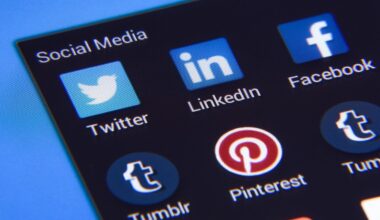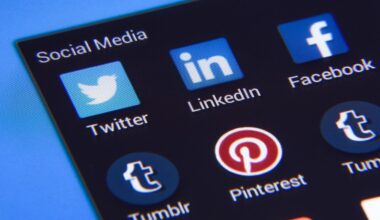Building Engagement with Animation on Multiple Social Media Platforms
In today’s digital landscape, animations hold significant potential for driving engagement across various social media platforms. They capture the attention of audiences, making messages more memorable and shareable. Animations can communicate complex ideas effectively, which is critical for brands aspiring to cut through the noise. Platforms such as Facebook, Instagram, and TikTok thrive on visual content, making animated posts particularly impactful for storytelling and brand identity. When businesses use animation effectively, they not only entertain but also convey their brand’s message succinctly. Plus, animated content resonates well with younger audiences, who prefer dynamic visuals over static images. With algorithms on many platforms favoring engaging content, animations can significantly enhance visibility. By integrating entertaining elements, brands can encourage shares, likes, and comments, amplifying engagement. However, quality is key; poorly executed animations can detract from a brand’s image. Social media managers should focus on creating polished and professional animations tailored to their audience’s preferences. Thus, animation continues to be a powerful tool, enabling businesses to enhance their reach and foster greater interaction among users across diverse platforms.
The creation of animated content involves several considerations to ensure it aligns with the brand’s identity and engages users effectively. Knowing the target audience is crucial; understanding their preferences and interests informs the tone and style of animations. For instance, younger audiences may resonate more with vibrant and playful animations, while professionals might appreciate more polished, minimalist designs. Furthermore, the platform dictates animation specifics; an Instagram Story demands bite-sized animations that grab attention quickly, whereas Facebook videos can be more elaborate. Consistency in branding, such as colors, logos, and messaging, reinforces brand recognition across platforms. Utilizing a common theme or storyline across different animations solidifies a brand’s presence in viewers’ minds. Moreover, leveraging analytics can provide insights into the performance of animations. Marketers should experiment with different styles and monitor engagement metrics closely to ascertain what works best. Additionally, collaborating with experienced animators or using user-friendly animation software can significantly improve production quality. Optimal animations are not just about visual appeal; they also need to convey clear messages, encouraging users to interact further with the brand’s content.
Types of Animation Techniques
Different animation techniques can be implemented based on the objectives and the audience of the campaign. Among the most popular methods is motion graphics, which combines graphic design with animation, effectively telling stories through visuals and text. This style is particularly suitable for infographics and promotional videos, succinctly delivering key messages. On the other hand, 3D animation offers a more immersive experience, ideal for product demonstrations and complex stories. Users can visualize products in a unique way, enhancing understanding and connection. Stop-motion animation, while labor-intensive, brings a quirky charm that can captivate audiences, especially on platforms like Instagram or TikTok where uniqueness matters. Additionally, character animation creates relatable figures that can embody a brand’s voice, fostering connections with viewers. Effective branding around these animated characters can create a loyal following. Incorporating sound effects alongside animations enriches the viewing experience, making content more enticing. Overall, selecting the right animation style is essential to ensure alignment with brand messaging and user expectations. Diversifying uses of these techniques allows brands to appeal to broader audiences across various platforms.
Embracing the latest animation trends can set a brand apart from competitors. One notable trend is the use of augmented reality (AR) animations, which allows users to interact with animated elements through their devices. This innovation creates an engaging, immersive experience that captivates users and encourages them to explore more content. Social media filters powered by AR have become immensely popular, particularly on Snapchat and Instagram, allowing users to engage playfully with a brand’s identity. Another emerging trend is incorporating cinematic animations, which elevate storytelling, creating a captivating phenomenon that keeps viewers glued to their screens. Text animations also take spotlight; they transform static captions into dynamic messages, increasing content retention. Besides trendy aesthetics, brands should focus on conveying authenticity and relatability through animations, aligning with current consumer preferences for genuine brand interactions. Story-driven animations are increasingly appreciated; sharing stories that resonate with users can spark deeper connections and loyalty. Moreover, cross-platform compatibility is crucial in today’s diverse social media landscape, ensuring animations function well across various formats without losing quality.
Measuring Engagement Success
Measuring the success of animated content involves tracking metrics that indicate user interaction. Essential metrics include views, likes, shares, and comments, which reflect how well the content resonates with the audience. The click-through rate can also provide insights into how effective the animations are at driving viewers to take action. Tracking these metrics over time allows marketers to refine their strategies and optimize future animations. Understanding audience feedback is paramount; monitoring comments provides invaluable insights into what users enjoy, dislike, or seek more from brands. Moreover, running A/B tests with varied animation styles can help clarify which elements generate the highest engagement. Customer surveys or polls can also gather qualitative data that enriches understanding of audience preferences. Additionally, brands should pay attention to their social media analytics dashboards to track performance over time. Consistently analyzing data empowers brands to stay adaptable to changing user behaviors. Over time, brands can build a repository of successful animation techniques that resonate with their audiences, ensuring content remains relevant and impactful.
Incorporating a strong call-to-action within animated content can significantly enhance engagement and drive interactions. Viewers often need direction about what to do next; clear, compelling calls-to-action can bridge this gap effectively. For instance, prompting viewers to ‘share this post,’ ‘follow for more,’ or ‘visit our website’ can provide tangible next steps that benefit the brand. Additionally, combining animations with strategic placements of calls-to-action can lead to higher conversion rates. For example, placing a call-to-action at the end of a video or animation ensures it remains top-of-mind as users finish consuming content. Brands should experiment with the placement, wording, and design of these calls-to-action to determine optimal effectiveness. Integrating QR codes in animations can also encourage users to engage with content in different ways, such as accessing exclusive content or promotions. Furthermore, leveraging user-generated content through animations encourages community engagement, inviting users to share experiences with the brand. This approach cultivates a sense of belonging among followers, ultimately fostering brand loyalty. Therefore, these animated content strategies contribute substantially to expanding audience engagement across social media platforms.
Future of Animation in Social Media
As technology evolves, the future of animation in social media appears bright and dynamic. Innovations in artificial intelligence can streamline animation processes, making them more accessible for brands of all sizes. Tools are emerging that leverage AI to generate animations with minimal user input, allowing small businesses to compete with larger enterprises. Furthermore, the advancements in virtual reality (VR) offer exciting potentials for creating immersive animated experiences that transcend traditional advertising. Brands can develop entire worlds where users can interact with animated characters and products, creating unique engagement opportunities. Moreover, short-form animations, such as those seen on TikTok, continue gaining traction, shaping how brands tell their stories succinctly. The emphasis increasingly lies on delivering messages quickly while ensuring attention-grabbing designs. As social media continues evolving, it is critical for brands to remain adaptable, embracing new platforms and formats for animation. Collaborating with emerging influencers who specialize in animated content can also strengthen brand presence. The fusion of creativity and technology will undoubtedly lead to innovative animation strategies that will captivate audiences on social media.
In conclusion, animation plays a vital role in enhancing engagement across multiple social media platforms. Brands that adopt creative and strategic animation techniques can effectively convey their messages, entertain audiences, and foster connections. By leveraging diverse animation styles, staying attuned to trends, and measuring success accurately, businesses can optimize their animated content strategies. Encouraging user interaction through compelling calls-to-action elevates engagement further, enabling a seamless transition from viewers to loyal followers. As the landscape of social media shifts with technological advancements, animators must remain vigilant in adopting the latest trends while ensuring consistent branding. The goal is to create animations that not only attract attention but also resonate with target audiences on a personal level. With the proliferation of AR/VR technologies, the possibilities for interaction and engagement through animation are boundless. As we look to the future of social media marketing, those who prioritize high-quality, relatable, and engaging animation will have the opportunity to thrive amid competition. Animation is not just an art form; it is now a significant asset in building meaningful relationships between brands and their audiences on various platforms.


